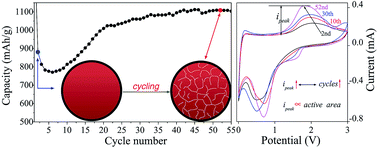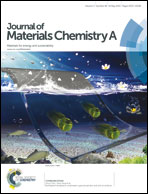Electrode activation via vesiculation: improved reversible capacity of γ-Fe2O3@C/MWNT composite anodes for lithium-ion batteries†
Abstract
Capacity fading caused by pulverization is the basic issue for transition-metal-oxide anodes in lithium-ion batteries (LIBs). Here we report a simple and scalable fabrication of core–shell structured γ-Fe2O3@C nanoparticle based composites incorporated with multi-walled carbon nanotubes (MWNTs), through a vacuum-carbonization of the synthesized metal–organic complex and MWNT hybrids. In the constructed γ-Fe2O3@C/MWNT architecture, the carbon shell layers can not only buffer the volume change of γ-Fe2O3 nanoparticles but also improve their conductivity; while the flexible and conductive MWNT networks can maintain the structural and electrical integrity of the electrodes during the charge/discharge cycles. As a result, such γ-Fe2O3@C/MWNT electrodes, tested as anodes for LIBs, exhibit excellent cycling performance with monotonically increased reversible capacities along with cycles. For instance, the specific capacity rises at a rate of ∼6.8 mA h g−1 per cycle to 1139 mA h g−1 after 60 cycles at the current density of 100 mA g−1. Such electrode activation was revealed to be closely related to the increased active surface area of the electrode arising from the gradual vesiculation in Fe2O3@C nanoparticles during lithiation/delithiation in the as-prepared robust γ-Fe2O3@C/MWNT architecture.


 Please wait while we load your content...
Please wait while we load your content...